Thailand has it all: pristine beaches, gorgeous mountains, relatively cheap costs, friendly locals and fantastic food. What’s not to like? For American travelers especially, Thailand is a hot-ticket destination right now because it doesn’t require a visa and the exchange rates are friendly on the wallet.
If you’re just starting to explore the idea of traveling to Thailand, this guide is for you. It covers:
- Why Visit Thailand?
- The Top Outdoor Activities in Thailand
- The Best Places to Visit in Thailand
- How to Plan Your Trip
Why Visit Thailand?
Thailand has something for everyone. Travelers who love the outdoors will revel in the pristine, glittering beaches of the south. In the north, the mountainous, green provinces offer crystal-clear waterfalls and meandering paths into the highlands. In the major cities of Bangkok and Chiang Mai, things are bustling: Food stalls waft tempting smells into the streets, which are full of motorbike-riding commuters carrying baskets, infants and stuffed shopping bags. Everywhere you look, there is something to explore and tempt your curiosity.
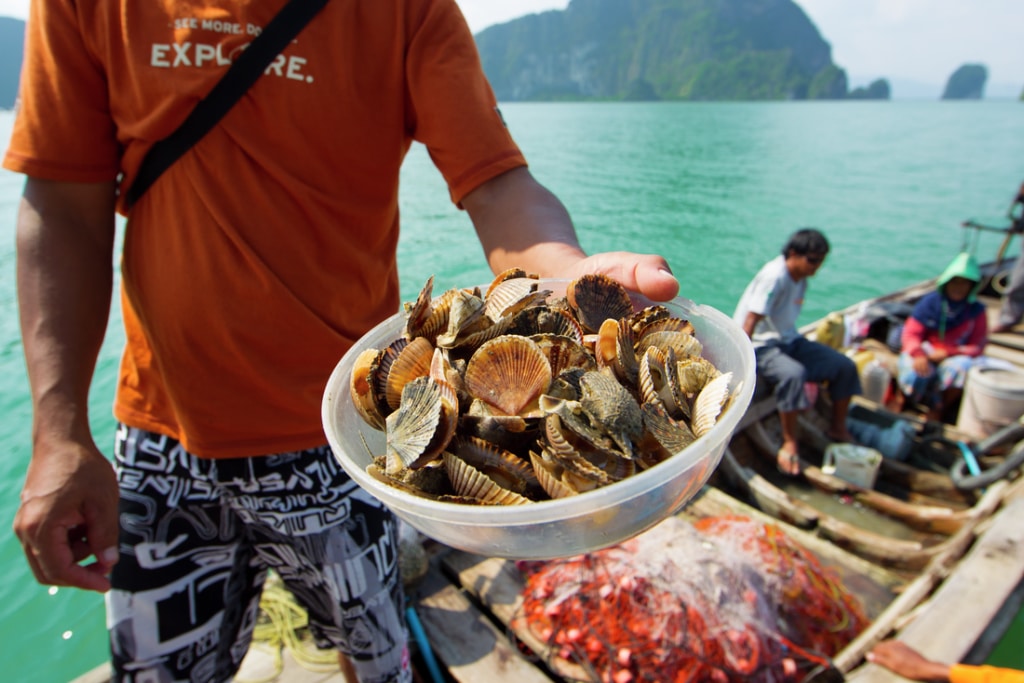
A local fisherman shows off a haul of clams fresh from the sea.
Thailand also offers relatively low costs for travelers from Western countries. At the time of writing, $1 USD is equivalent to about 32.9 baht. For reference, a basic Thai meal costs around 150 baht maximum, which means travelers typically pay $5 or less for dinner. If you eat street food while in the country (and you should!), the costs are even lower. Although the costs of hotels in Thailand have grown in recent years as more tourists visit the country, the rates are still low compared to typical rates in the U.S. (Often, mid-range rooms in Thai hotels cost less than $50 USD/night).
The Top Outdoor Activities in Thailand
Hiking & Backpacking: Thailand is a beautiful place to hike: Pristine rain forests, stark mountains and refreshing lakes abound. But unlike the U.S., where trails are well-marked, Thailand rarely offers established hiking trails, which means your hiking excursions will require a bit of extra planning.
Some of the most popular trekking routes in Thailand include:
-
- Khao Sok National Park is located in Surat Thani, in southern Thailand, and it boasts sandstone and mudstone rocks rising up above the blue sea, backed by karst limestone topography filled with green foliage. While trekking in the jungle here you’re likely to see elephants, tigers, Malayan sun bears and more than 180 bird species. There are also waterfalls and caves interspersed throughout—but you’ll want a guide to help you find them.
- Hiking Doi Luang Chiang Dao, which is an hour north of Chiang Mai, offers views of hill tribe villages, riverside landscapes and forests. It’s a tough hike to the top of the mountain, but you can make it up and back in about 8 hours, as it’s roughly 7.5 miles round trip, with or without a guide.
- Umphang Valley is about halfway between Chiang Mai and Bangkok and is best explored on a guided three- or four-day trek that takes you to a tribal village and the Thi Lo Su waterfalls.
- There are few better vantage points over the Andaman Sea than the Kho Phi Phi Viewpoint, which takes you 600+ feet up and away from the tourist crowd. You can accomplish this hike in 30 minutes or less, and there are snacks and cold drinks for purchase at the top.
- Hire a guide to take you to the Chiang Rai hiking trails in the forests of Chiang Mai’s sister city, Chiang Rai, where you can spend up to a week trekking to waterfalls and vistas.
Climbing: Lovers of limestone flock from all over the world to pay homage to Thailand’s infamous karst formations, particularly at Railay and Tonsai beaches. For some ropeless (and wet) action, try one of the deep-water soloing excursions on tap off the Krabi coast.
Yoga: Thailand is a hot spot for yoga, and specifically yoga retreat centers and teacher training programs. Chiang Mai and Chiang Rai house much of the yoga scene because of their reputation for being a haven for expats, artists and Buddhist thought. The southern islands also offer many idyllic yoga chalets and practice centers for yogis from around the world, especially on Koh Chang and Koh Samui.
Kayaking: The southern islands of Thailand are full of sea caves, tunnels, wildlife and lagoons, which make them a perfect location for sea kayaking. This activity, too, is best undertaken with a guide, as the currents can be unpredictable and it’s typically difficult to find your way in and out of the lagoons without expert help. There are also other places to kayak—the River Kwai, which is a day trip from Bangkok, is a popular option.
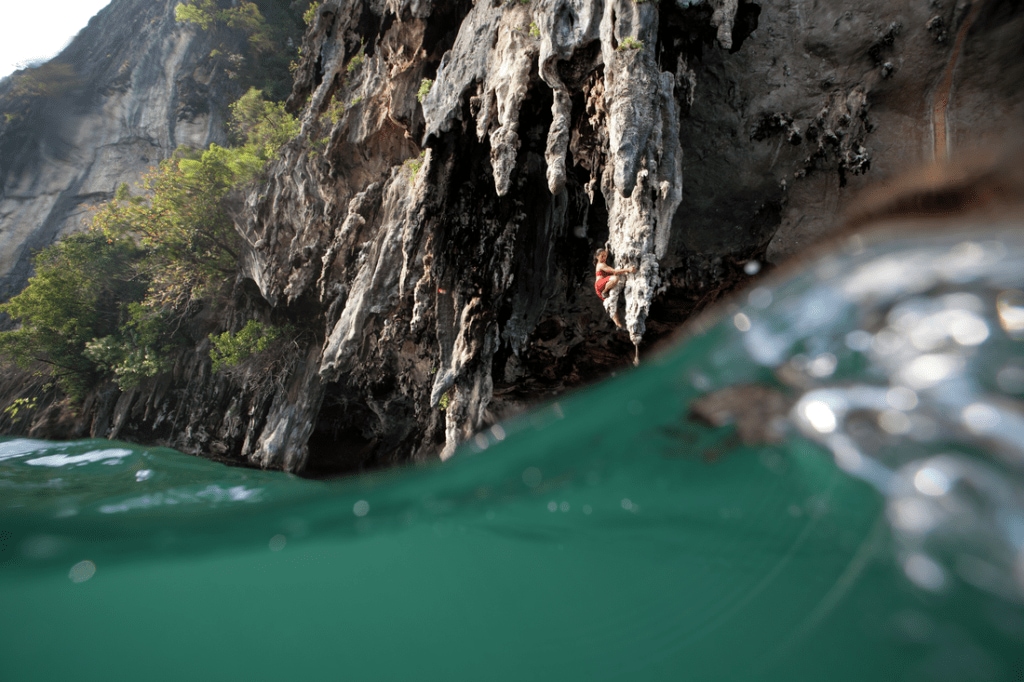
A deep-water soloist negotiates a limestone stalactite near the climbing mecca of Tonsai Beach.
Scuba Diving & Snorkeling: Thailand is known to be one of the most affordable places in the world to get a PADI Open Water Diver certification. Head to the Thai islands down south to check out a myriad of underwater glories: The Gulf of Thailand in the East and Andaman Sea in the West offer diving opportunities that include deep dropoffs, reefs, walls, caverns, tunnels, pinnacles, open ocean seamounts, wrecks and more. Lovers of pelagics will find whale sharks, manta rays, white-tip and leopard sharks, as well as seahorses, frogfish, ghost pipefish and a variety of crustaceans.
Second only to Cairns, Australia, in terms of PADI certifications issued worldwide per year, Koh Tao is Thailand’s diving mecca, and has dozens of credentialed PADI dive shops that can help you get started (or farther along) on your scuba journey.
For those who would rather see underwater creatures from a distance, snorkel tours are offered daily from almost every hotel on most Thai islands.
The Best Places to Visit in Thailand
Bangkok
Visitors to Thailand typically fly into Bangkok International Airport (BKK – Suvarnabhumi), which is one of the busiest airports in southeast Asia. Bangkok, or Krung Thep Mahanakhon, as it’s known to the Thais, is the capital of Thailand and its largest city.
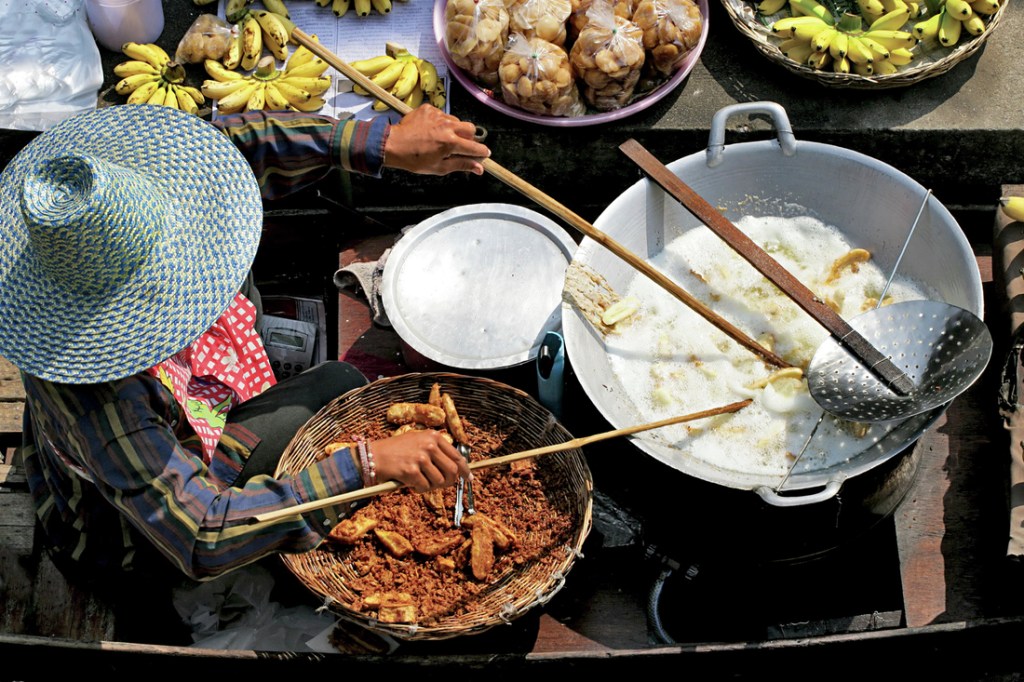
A merchant prepares sweet banana snacks at one of Bangkok’s floating markets.
Bangkok is a bustling, loud, crowded city that offers options for every traveler. While in Bangkok, visitors often explore Thai temples and eateries. Some of the most popular things to do in Bangkok include:
- Wat Pho: This well-known temple is home to the Reclining Buddha, a 15-meter-tall and 46-meter-long golden Buddha statue. If you’re wearing a tank top and shorts, bring a scarf to cover your shoulders and pants to cover your legs for entering the temple. (Wat means “temple” in Thai.)
- Wat Arun: The Temple of Dawn is hard to miss, with its towering spires and radiant glazed porcelain.
- The Grand Palace: This palace was once home to the King of Thailand and much of the country’s governmental business is still carried out there.
- Chatuchak Weekend Market: Covering more than 35 acres, this weekend-only market has more than 8,000 stalls selling everything from toys and jewelry to Thai iced coffee—and so much more.
- The River Ferry: Thailand is sometimes called the “Venice of the East,” because it’s built around the Chao Phraya River. While you can certainly get around Bangkok using cabs or tuk tuks (see our “how to get around” section below), a ferry ride is another fun transportation option.
- Khao San Road: If you want a bustling travel experience, look no further than Khao San Road. Packed with tiny stalls selling everything you can imagine and lined by hostels and hotels, Khao San is a street with a pulse. If you’re looking for a night out on the town, Khao San Road is a great place to start.
Other popular activities in Bangkok involve getting massages at local spas, shopping in the giant malls and eating street food. Some visitors also choose to venture outside of Bangkok to take popular day trips, including:
- Ayutthaya: This UNESCO World Heritage Site features the ancient ruins of Siam’s former capital city. Many people choose to explore the vast ruins via rented bicycle, and you can visit by train or as part of a guided tour.
- Damnoen Saduak Floating Market: This floating market (one of many) is a bit of a trip outside of Bangkok (a little over 60 miles), but it’s well worth it to see the more than 200 venders selling their wares out of boats. Come to the market via taxi or public bus and grab dinner before heading back to the city.
- Koh Si Chang: While most people head to the southern islands for beach time, this small island is a lesser-known but very enjoyable day trip from Bangkok. Take a bus or taxi to the ferry, which leaves hourly.
- Erawan National Park: Come for the emerald green ponds and stay for a seven-tiered waterfall. It’s a possible day trip from Bangkok via minivan or guided tour, but an overnight stay in Kanchanaburi, the province where this national park is located, will permit more time for exploration.
Chiang Mai
After spending a few days in Bangkok sleeping off the jet lag, shopping, eating delicious street food and exploring temples, many travelers head up north by plane or bus, to Chiang Mai. Chiang Mai is the largest city in northern Thailand and features a bohemian vibe and a centuries-old walled district that holds the lion’s share of the action.
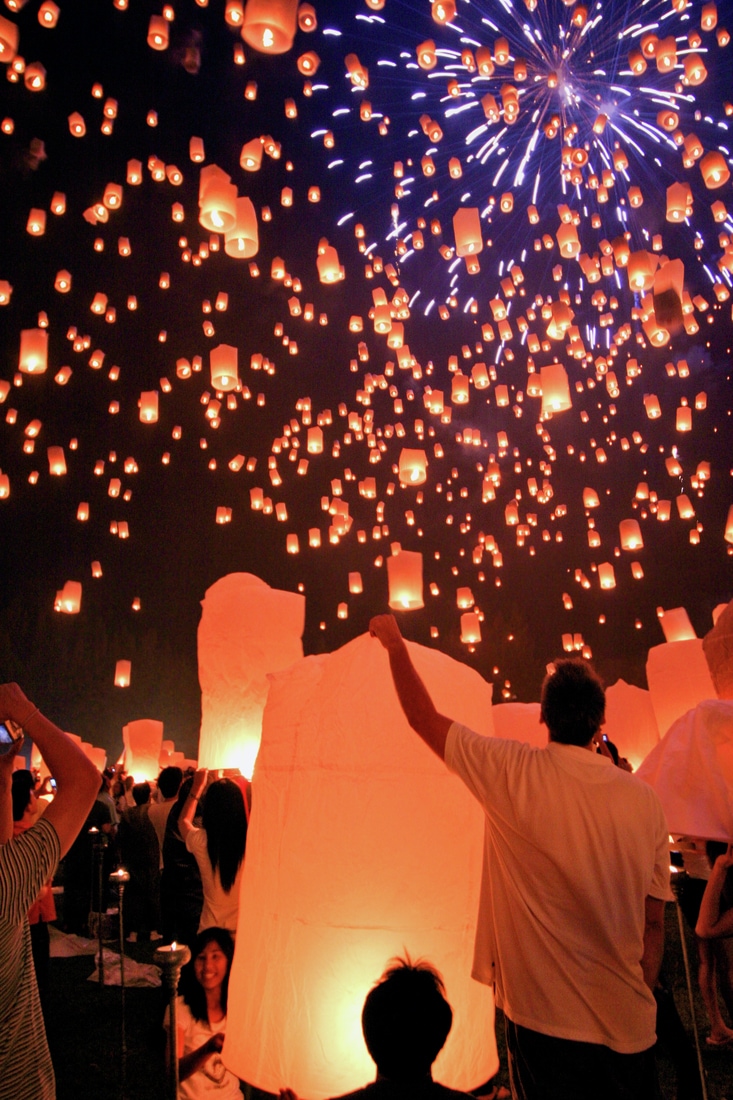
Chiang Mai’s Yi Peng Floating Lantern Festival lights up the night sky.
When visiting, travelers typically enjoy:
- Doi Suthep: This mountaintop temple is a 30-minute taxi ride from the old walled city and boasts golden spires, lovely gardens and far-reaching views.
- Nimmanhaemin Road: Also known as the Nimman Road, this hip street is full of boutiques, restaurants, galleries and coffee shops. Check out the local art and grab a tasty snack at one of the many happening eateries.
- Huay Kaew Road Night Market: This market, located outside of the old city’s gates, focuses mostly on fashion. If shopping is your game, you can find (or haggle for) a great deal during this nightly affair.
- The Old City Temples: Wat Chedi Luang is located right in the middle of the old city, as are Wat Phra Singh and Wat Suan Dok. All are worth a visit as you wander by; just bring a scarf to cover your shoulders.
- Wiang Kum Kam: Outside the old city, about 3 miles south of Chiang Mai, you’ll find the ruins of an ancient city dating back to the eighth century that you can explore by horse-drawn cart or rented bicycle.
- Elephant Nature Park: There are several elephant sanctuary options in the Chiang Mai area, where you can visit elephants, assist with their rehabilitation and even donate your time to keep facilities clean.
- Take a cooking class: Inquire with your hotel or hostel manager about taking a cooking class, which will help you understand the mostly vegetarian styles of cooking found in the northern province.
Chiang Mai also serves as a jumping-off point for outdoor adventurers. Popular adventures in the northern provinces include:
- Pai: Backpackers flock to Pai, a small riverside town in northern Thailand. Taking a motorbike, minibus or taxi to Pai will take four winding, potentially nauseating hours from Chiang Mai. Once there, you’ll have your pick of hikes to various waterfalls in the hills.
- Zip-Lining: There are many zip-line systems in the forests around Chiang Mai, which make for a perfect day trip.
- Trekking: Doi Inthanon, the highest mountain in Thailand, offers trekking options for adventurous travelers. Doi Luang Chiang Dao is another popular hike in the area.
- Chiang Dao Caves: Just a few hours from Chiang Mai, you’ll find two well-lit caves which can only be visited with guides.
- Bua Tong Sticky Waterfalls: A 90-minute drive from Chiang Mai will get you to the “Sticky Falls,” a waterfall where the rocks are covered in a mineral deposit that allows your feet to stick to the rocks despite the cascading water.
Island-Hopping
After spending time up north, many visitors head to the islands. This involves flying or busing south, then catching a ferry to one of the many islands surrounding the southern tip of Thailand. The most popular islands (Koh means “island” in Thai) include:
- Koh Phi Phi: With its white sand beaches and sparkling blue waters, Koh Phi Phi is just a 90-minute ferry ride from Phuket. Although it’s become touristy, you can’t beat the warm water and views.
- Koh Yao Yai: Yao Yai island and its sister island, Yao Noi, are a quick ferry ride from Phuket. They are less developed than many of the other islands in the area.
- Krabi: While not an island, the Krabi province offers a laid-back alternative to Phuket. Tonsai Beach and Railay Beach are the most popular places to visit.
- Koh Lanta: This island is easiest to reach from Krabi, but you can also get there via a boat from Phuket. It’s quieter than Phi Phi and while developed, you’ll be mostly on your own with the locals during your adventures.
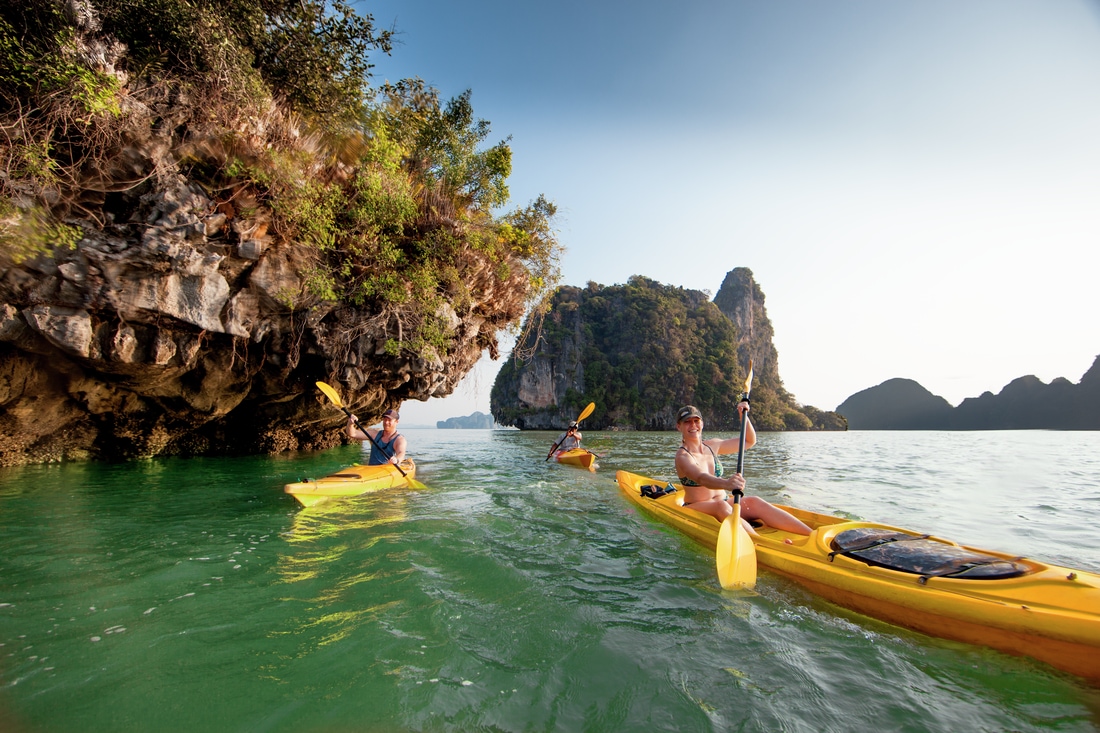
Sea kayakers explore the wonders of karst topography in the Krabi region of southern Thailand.
- Koh Samui: Known as the “glamour” island and offering upscale resorts and high-end restaurants, this piece of paradise is best accessed by ferry from Surat Thani. You can also fly onto the island via a small airport. Koh Samui is home to many yoga retreat centers.
- Koh Phangan: Known for its wild full-moon parties, Koh Phangan can be reached by ferry from Koh Tao, Koh Samui or Surat Thani. There are 20 nearby dive sites, which makes this location a good one for scuba enthusiasts. Be careful with booking near the date of the full moon, as accommodations fill up quickly.
- Koh Tao: Located north of Koh Phangan, you’ll find tiny Koh Tao, which means “turtle island” in English. This island offers spectacular diving, crystal-clear water, beautiful beaches and world-renowned dive centers (and rates) for certification. Catch an overnight ferry with the locals—or a speedier vessel with other travelers—from Chumphon.
How to Plan Your Trip
Best times to visit: Thailand’s monsoon season lasts from mid-summer (usually beginning around mid-July) to mid-fall (ending around October). Most experts recommend avoiding travel to Thailand during these months; the northern cities are chilly and wet, and the islands are drenched. During this time of year, Bangkok is known to flood. In April and early May, temperatures can rise to 105 degrees F with plenty of humidity.
Most visitors choose to come to Thailand during the North American winter, when the weather is most temperate. From November to March, temperatures typically sit between 75 and 90 degrees, which is enjoyable at the beach and in the city.
Where to stay: From dorm bunk to private villa, Thailand offers the full gamut of hotel, hostel and bed-and-breakfast options for visitors. You should always check reviews before booking. Chiang Mai, in particular, is known for its many boutique hotel options within the old city’s walls. Backpackers frequent Thailand because of the low cost of accommodation, especially in hostels (where a bed can cost less than $10 USD per night).
What to pack: Pack for warm weather. We recommend throwing the following items in your pack:
- Rain poncho
- Lightweight clothing (mostly shorts and T-shirts), to accommodate the humid weather
- Flip-flops
- Supportive walking shoes
- Bug repellent
- Sunscreen
- Sarong (or buy one at the beach)
- Small first-aid kit with antibacterial lotion
If you plan to dress in shorts and a T-shirt each day, bring a covering with you in your daypack. Temples require visitors to cover bare shoulders and legs, so packing a scarf to tie on as a skirt, or lightweight pants and a long-sleeve shirt, is a wise idea.
Generally, you can find whatever you need—but forgot to bring—in the local stores.
Getting From Place to Place
You have several transportation options in Thailand, including:
Tuk tuks: We recommend taking tuk tuks from place to place within Thailand’s larger cities, like Bangkok and Chiang Mai. A tuk tuk is a motorcycle with a cart attached to the back—you’ll see them everywhere in the country.
Official taxis: Cabs can be found throughout Thailand’s major cities, and you can flag them down easily by waving. There are also taxi stops in busy areas. Make sure your driver starts the meter before you leave your initial location—otherwise, you may be overcharged. You should also make sure that they have official, government-issued cards on their dashboard, especially when you’re traveling from airports into the cities. Most travelers take cabs from the airport to their hotel; simply walk up to a taxi stand and ask for a ticket, and you’ll be directed to the nearest empty vehicle. You can also use GrabTaxi, a well-known ride-hailing platform that offers a convenient way to get a taxi in many Asian cities.
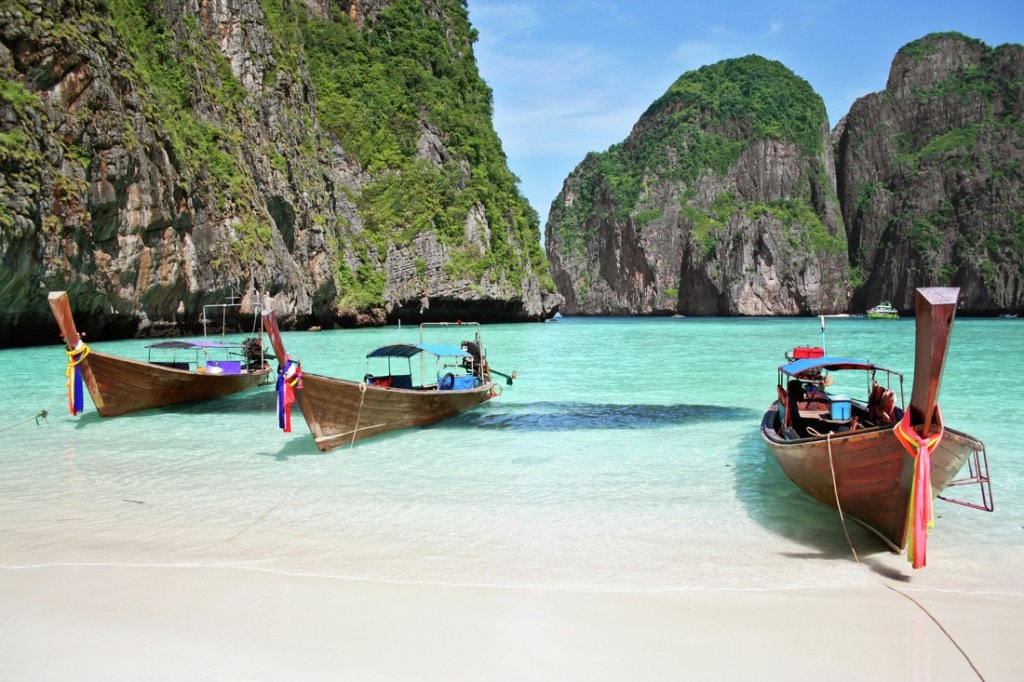
Colorful long-tail boats sit anchored in Koh Phi Phi’s iconic Maya Bay.
Songthaews: In some cities, like Chiang Mai, you’ll see songthaews. These are red pickup trucks with coverings in the back, and they act as shared taxis—people will get on and off throughout the ride, but you’ll eventually get to your destination. You can also hire a songthaew for the day to take you to see destinations outside the cities.
If you plan to travel between the major urban areas, like Chiang Mai and Bangkok, you’ll have several different options: overnight buses, trains and planes. Typically, because of the low cost of flights, airplane travel is the way to go. However, for travelers on a budget, trains and buses may offer a cheap option that can also double as a night of housing.
Money: Thai currency is called baht. At the time of this writing, the U.S.-to-Thai exchange rate is $1 USD to 32.5 Thai baht. Exchange some money at a bank before you go—or exchange money at the airport. If you need to break bigger bills once you’re in the country (sometimes taxis and street vendors won’t have change), head to the local 7-Eleven.
What to eat and drink: Thai food has a reputation for being flavorful and delicious. As a tourist, it’s still easy to get authentic Thai food from restaurants or on the street.
Some may caution you against eating “street meat,” but most local Thais will tell you that street food is safe and also an important part of the Thai cultural experience. When you’re choosing where to eat on the street, a good rule of thumb is to follow the locals. Another is to make sure that any food you’re eating is made fresh, right in front of you.
Key phrases to know:
“Hello”: For women: Sawadee ka; For men: Sawadee krab
“Thank you”: For women: Kob Khun Kha; For men: Kob Khun Krab
“No thank you”/ “I don’t want it” (polite): Mai Aow
